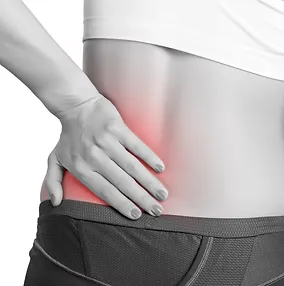LumbarSpondylolithesis

Lumbar spondylolisthesis is a condition that causes lower back pain. It occurs when the stability of your lumber vertebrae is compromised and the vertebrae slips forward out of position. This can cause minor pain that quickly progresses if left untreated.
Do I have lumbar spondylolithesis?
Lumbar spondylolisthesis is diagnosed with a physical exam and an X-ray to confirm a crack or fracture in the vertebra. Your doctor will also look for the telltale movement of the vertebra (usually seen on an MRI). In addition to these tests, your doctor will ask you to describe your symptoms.
For you, this may only be lower back pain. Many patients may not experience many spondylolisthesis symptoms in the beginning stages. If the fracture is small and the patient is in general good health, they may only feel pain similar to a muscle strain in the low back.
Over time, though, symptoms may progress and include the following:
-
Pain radiating to the buttocks and back of the thighs
-
Pain that gets worse with activity and improves with rest
-
Muscles spasms
-
Stiffness in the lower back
-
Tight hamstrings (muscles at the back of the thighs)
If the condition remains undiagnosed and untreated, symptoms can progress to sciatica pain as the vertebrae apply pressure on the sciatic nerve. Pain can radiate across, down the hip, and into the leg. It may be accompanied by weakness or numbness. It can eventually make sitting or standing for prolonged periods of time very uncomfortable.
There is a subtle difference in spondylolisthesis vs. spondylolysis. Spondylolysis refers to a crack or fracture in the vertebrae. Seen most often in children and adolescents, this is most often a result of activities that place repetitive stress on the back, including gymnastics, football, and weight lifting.
When the fracture weakens the vertebrae so that it starts to shift or slip out of place, this condition is called spondylolisthesis.
For younger people, the most common cause of spondylolisthesis is a fracture or instability caused by repetitive stress and excessive activity placed on the spine. Fractures in adolescence may go undetected and not create issues until the discs begin to move.
In adults, degenerative spondylolisthesis can occur without injury. As we get older, general wear and tear begins to take its toll on the spine. The discs that cushion movement become dry and brittle, and they begin to flatten. This disc degeneration can lead to degenerative spondylolisthesis (DS). The disc above, with the looser ligaments of the spine that are worn with age and no longer supporting it, begins to slide forward and over top of the disc below.
Age and gender are risk factors for degenerative lumbar spondylolisthesis. Women over 50 are more likely to develop this condition. This may be related to fractures occurring due to osteoporosis. Similarly, African Americans are more likely to develop lumbar spondylolisthesis.
As with many conditions, people who have underlying health conditions, including obesity, diabetes, arthritis, and osteoporosis have an increased risk of lumbar spondylolisthesis.
Our team at North Texas Neurosurgical Consultants believes in approaching lumbar spondylolisthesis treatment in a comprehensive way. Starting with lifestyle interventions, we prescribe adding more exercise, stopping smoking, and using dietary interventions to support overall health and wellness. Physical therapy can offer a structured way to increase spinal health and improves outcomes for many patients. While exercise and diet alone will not repair a fracture or move a vertebra back into place, overall good health improves surgical outcomes and the chances of success with other treatments.
For patients with spondylolysis, steroid injections may help relieve pain during the physical therapy process. This can potentially prevent a progression to lumbar spondylolisthesis while the fracture heals and the patient regains strength in the back and core muscles.
Finally, in cases where non-invasive and minimally-invasive techniques have failed to provide relief, we offer a variety of surgical techniques that can help.
SPINAL FUSION
Spinal fusion is a surgical technique utilized when other conservative treatment approaches have failed. For lumbar spondylolisthesis, the vertebrae are moved into the correct position and a bone graft replaces the damaged or worn out disc. Special hardware holds the bones in place while they heal, giving the bones time to come together.
SPINAL CORD DECOMPRESSION SURGERY
When lumbar spondylolisthesis is causing painful pressure on the nerves, spinal cord decompression surgery creates space between the vertebrae. Opening up this space (and performing spinal fusion for increased stability when necessary) relieves painful pressure on the nerves.
POSTERIOR LUMBAR INTERBODY FUSION
Posterior lumbar interbody fusion is a procedure that addresses stubborn back pain involving the intervertebral discs. When performing an interbody fusion procedure, your surgeon will remove the injured or dysfunctional disc, gently moving the nerves in that space to the side. The disc is replaced by a bone graft and a metal cage that is further stabilized with screws or rods. A posterior lumbar interbody fusion is performed with a smaller, less invasive incision in the back of the body.
LUMBAR LAMINECTOMY WITH NERVE ROOT DECOMPRESSION
The back of each vertebra has lamina, that is, connective tissue that covers and protects your spinal canal. A lumbar laminectomy removes the lamina to relieve pressure on the nerves and the spinal cord.
This decompression can ease severe, chronic, and excruciating back pain when other more conservative treatments have been unsuccessful. The lamina may not be involved in lumbar spondylolisthesis, but in cases where it is causing pain, this intervention can help.
How We Can Help.

Approach
Even if your lumbar spondylolisthesis pain has been a long time coming, once it hits, you will want to find long-term relief. Dr. Rosenstein at North Texas Neurosurgical Consultants provides the highest standard of care to patients with complex health conditions. Contact 817-467-5551 or fill out the form on our contact us page for more information.
